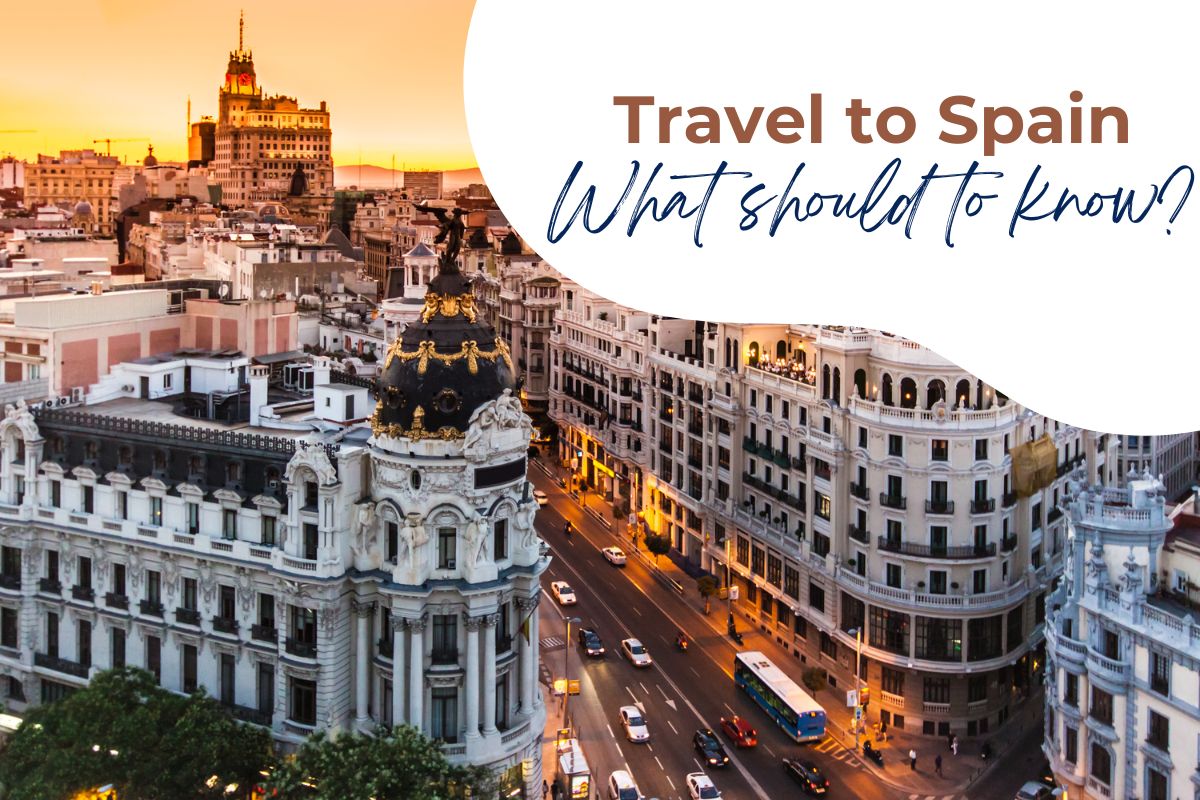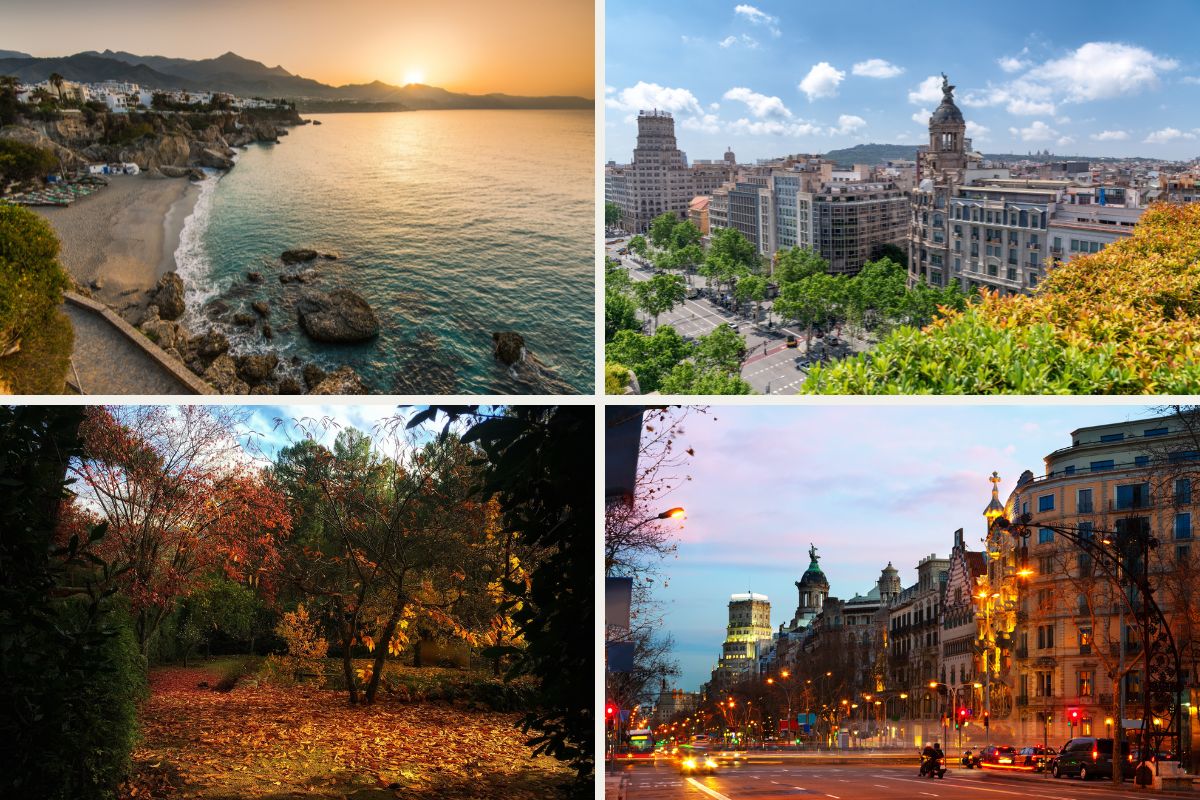Spain is a wonderful destination for visitors because of its amazing cuisine, beautiful beaches, and rich history. However, these are a few things you should know about traveling there before you book a ticket. This guide will cover everything for your upcoming Spain trip!

Is Spain safe for travel?
Spain is mostly safe for visitors. Bad crimes don’t happen often (Spain’s homicide rate is quite low, about 1 incident per 100,000 people). But still, be careful in busy places and on buses or trains.
The best time to visit Spain
The best time to visit Spain is based on your preference, there are many recommendations for your trip:

- Spring (March to May): Great for city trips to Madrid, Seville, or Barcelona. Mild weather, fewer tourists, and flowers in bloom.
- Fall (September to November): Fall in Spain is like spring, with nice weather and fewer crowds. It’s the best time to visit Seville, Granada, and Madrid for cultural events, or explore the Pyrenees
- Summer (June to August): Perfect for beach holidays on the Mediterranean coast or Balearic Islands. But expect heat and lots of tourists in popular spots like Ibiza.
- Winter (December to February): Good for avoiding crowds. Try skiing in the Pyrenees or Sierra Nevada. Southern Spain stays fairly warm.
Visa for Spain
The first time you should know when you want a trip to Spain is the visa rules. Below is a table for visa requirements for different categories of travelers:
| Category | Who Qualifies | Visa Requirement | Stay Duration | Additional Notes |
| EU/EEA Citizens | Citizens of EU/EEA countries | No visa required | Unlimited | A valid passport or ID card is required. Visitors can live, work, and study in Spain without restrictions. |
| Visa-Exempt Countries | U.S., Canada, Australia, Japan, and others | No visa is required for short stays | Up to 90 days within 180 days | ETIAS is required starting in 2024. This applies to tourism, business, or short visits in Spain. |
| Schengen Visa | Non-visa-exempt countries (e.g., India, China, Russia) | Schengen visa required | Up to 90 days within 180 days | Application through the Spanish consulate; must provide a passport, travel itinerary, proof of accommodation, insurance, and financial means. |
| Long-Stay Visas | All nationalities (for stays over 90 days) | Long-stay visa required (work, study, family reunification) | Over 90 days | Requires specific visa type based on purpose; detailed documentation needed; apply well in advance. |
Internet in Spain for tourists
1. EU Roaming
If you’re from the EU, your home plan may work in Spain, which means you use your existing mobile plan in Spain without extra charges due to the “Roam Like at Home” policy. However, there can be Possible data limits and it’s not available for non-EU visitors
Major EU mobile operators offer “Roam Like at Home” services and extensive 4G and 5G coverage across the country such as Vodafone, Orange, T-Mobile, Telefónica (O2), and Three.
- Speed: Good overall
- Cities: 30-60 Mbps (4G), faster with 5G
- Rural: Slower but usually adequate
- Coverage: Extensive
- Urban/tourist areas: Near-total 4G, growing 5G
- Rural: Good 4G, some 3G in remote spots
2. Pocket Wifi
Pocket Wi-Fi is a popular option for tourists in Spain. It’s a small portable device that provides a Wi-Fi connection through the mobile network. Ìf you use this, then you can connect your smartphone, tablet, laptop, or other devices at the same time. That also means pocket wifi is very useful for group use.
However, remember to consider the advantages of Pocket Wifi:
- Cost: Pocket wifi is more expensive than alternatives like SIM cards, from $5 to $15 per day.
- Battery Life: Limited to around 6-10 hours
- Remote Coverage: May have weaker signals or slower speeds in rural or remote areas.
3. SIM Cards
SIM Card is a small, removable smart card used in mobile phones that stores your phone number and connects you to your mobile network in Spain.
- Using SIM cards is very convenient because: You can easily transfer your number and data to a new phone by swapping the SIM.
- SIM Card in Spain provides reasonable local rates for data, calls, and texts
- You can switch between compatible carriers without changing phones.
- However, make sure that your phone is already unlocked to use a local SIM card. Installing a new SIM card gives you a new phone number, temporarily disabling your original number.
Here are some SIM Cards plans for your Spain trip:
| Provider | Price (USD) | Data | Validity | Additional Features | |
| Movistar | $22 | 40GB | 30 days | Extensive coverage across Spain and the EU | |
| Vodafone | $11 – $33 | 25GB – 120GB | 30 days | Good coverage, free SIM with online order | |
| Orange | $30 | 8GB | 14 days | Unlimited calls/texts in Europe | |
| Orange | $50 | 20GB | 14 days | Unlimited calls/texts in Europe |
Read also: Choosing the best Spain SIM card for your travel
4. Spain eSIM
With the development of technology, eSIM has been becoming a popular choice for Spain visitors. It is a digital SIM that can help you activate a mobile plan without using a physical SIM card.
Many people love using eSIM because of the reasons below:
- Instant Activation: Visitors can buy and activate it before their trip.
- No Need for Physical SIM: eSIM is ideal for phones with eSIM capability.
- Keep Your Original Number: eSIM works alongside your primary SIM, which means you can keep your phone.
However, not all phones support eSIM, make sure your phone supports eSIM service and not is an unlocked phone before buying an eSIM plan.
There are many options for eSIM plans from reliable providers such as esimspain.net, Airalo, Nomad, and Holafly. The table below will help you choose the best eSIM plan for your Spain trip:
| Provider | Price (USD) | Data | Validity | Additional Features |
| esimspain.net | $12.9 | 1GB/day | 7 days | Unlimited calls within Spain |
| esimspain.net | $43.9 | 1GB/day | 30 days | Unlimited calls within Spain |
| Holafly | $19 | 5GB | 7 days | Unlimited data options are available |
| Holafly | $34 | Unlimited Data | 30 days | Unlimited calls in Europe |
| Airalo (Guay Mobile) | $5 | 1GB | 7 days | Easy online activation |
| Airalo (Guay Mobile) | $26 | 20GB | 30 days | No calls included |
| Nomad | $8 | 3GB | 7 days | Compatible with most devices |
| Nomad | $27 | 20GB | 30 days | Multi-country support available |
Consider buying an eSIM plan, Spain visitors should review how long their stay in Spain is:
- Short Trip (1-7 Days): A data plan like 1GB/day from esimspain.net ($12.9) or 5GB from Holafly ($19) is ideal to cover basic needs.
- Medium Trip (7-14 Days): Consider a mid-range plan like 8GB from Orange Holiday ($30)
What to pack for Spain
To have a great time in Spain, here are things to pack beside your clothes:
Adaptor for electrical outlets (Spain uses Type C and F plugs)
Euros (cash) and credit cards
Spanish Translation App might help communicate in less touristy areas.
Refillable water bottles because tap water in Spain is safe to drink, so a reusable bottle can save money and reduce plastic use.
Basic first-aid kit and any personal medications
How much does a trip to Spain cost?
When planning your Spain trip, make sure you budget your daily needs before the trip. Below is a detailed table that outlines estimated daily costs:
| Expense Category | Daily Cost Range (USD) | Explanation |
| Accommodation | $50 – $150 | Budget hotels or hostels range from $50-$80 Mid-range hotels cost $80-$150 per night. |
| Food | $25 – $60 | $25 covers simple meals at local cafes $60 allows for dining at nicer restaurants. |
| Transportation | $10 – $30 | Public transport like buses or metros costs $10-$15 Taxis or car rentals may reach $30. |
| Activities | $15 – $50 | Entrance fees for attractions range from $15-$30 Guided tours or special experiences can go up to $50. |
| Miscellaneous | $5 – $20 | Covers snacks, small purchases, or tips, depending on daily spending habits. |
| Total Daily Cost | $105 – $310 | The total varies based on accommodation, dining, and activity choices |
Overall, this is an estimated budget for a one-week trip to Spain:
- Budget Trip: $735 – $1,470
- Mid-Range Trip: $1,505 – $2,800.
- Luxury Trip: $3,000+
To help you save money on your trip to Spain, here are some simple tips:
- Take advantage of free museum days and city tours
- Buy a tourist travel pass for discounts on attractions
- When having meals at restaurants, look for “Menu del Día” lunch specials.
- Use a no-foreign-transaction-fee credit card
Best things to do in Spain
Visit the Sagrada Familia in Barcelona
This is a massive and rather exceptional church located in Barcelona. They have a castle-like structure with two large towers tapering at the top. It is also very beautifully designed on the inside with superb stained glasses. From the time of its construction, it has taken more than a hundred years to complete this beautiful church, and the work is not yet done. When you get there, you will definitely love it because it’s so different from other churches, it is unique.
Explore the Alhambra in Granada
It is a palace and fortress complex located on a hill that dates back to the past. It was erected by the Muslim rulers many centuries back. Inside you can find the beauty of gardens, fountains, and rooms decorated with carved and tiled works. It is like walking into the middle of a fairy tale castle but with an array of different cultures.
Relax on Costa del Sol beaches
In Spanish, the name of this beach – Costa del Sol means “Coast of the Sun”. It’s a long stretch of beaches in southern Spain. The weather is usually warm and sunny, which is suitable for you to swim, sunbathe, or try water sports. There are many towns along the coast with hotels, restaurants, and shops. It’s a great place to unwind and enjoy the Mediterranean Sea.
What to buy in Spain
Buying special things in Spain can make your trip even better. These souvenirs will help you remember your vacation long after you return home.
- Local Crafts: Handcrafted items like ceramics from Andalusia, espadrilles (traditional footwear), and intricate lace from Galicia.
- Gourmet Food Items: Spanish olive oil, Manchego cheese, Iberian ham, saffron, and local wines.
- Souvenirs: Flamenco-themed items from Seville, Gaudí-inspired trinkets from Barcelona, and postcards or art prints.
- Football merchandise: Items from popular teams, such as Real Madrid or FC Barcelona jerseys.
What to eat in Spain
Spain has wonderful cuisine, here is a list of dishes you should try when you have a trip in Spain:
- Paella: A rice dish originating from Valencia, typically made with saffron, vegetables, and various meats or seafood.
- Tapas: Small plates of various appetizers or snacks. Popular tapas include Patatas bravas (spicy potatoes), Gambas al ajillo (garlic shrimp), and Croquetas (fried rolls with various fillings).
- Tortilla Española: This is a classic Spanish omelet made with eggs, onions, and potatoes.
Conclusions
That was all about the preparation for the Spain trip! Remember to relax and enjoy your journey. Hope that with these tips, you’ll have an unforgettable time in Spain. ¡Buen viaje! (Have a good trip!)